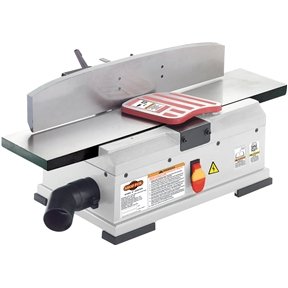The Benchtop Jointer is a high-speed, stationary power tool. It is a table comprising 2 flexible surfaces: an infeed and an out feed. Between both of these flat surfaces is an opening below which are razor-sharp knives which rotate at a high speed. By adjusting the height of the infeed surface that the knives will shave wood from a plank fed through the Benchtop Jointer. An adjustable fence Lies at right angles to the table. This permits the adjustment of the width of this table to the width of a plank being shaved by the blades. A 6-inch Benchtop Jointer can only plane board widths up to 6 inches. An 8-inch Benchtop Jointer can airplane around 8 inches, etc. If you were to examine a piece of fine furniture made from different pieces of wood, you’d probably find a board on the left side being the exact same size as the corresponding board on the right side.

Plank on the top being the identical size as a board at the bottom, etc. Many pieces of furniture need to keep a symmetry in other words what is on one side must look exactly the same on the other hand or the piece does not look right. After cutting pieces of stock to slightly larger dimensions than are required, a Benchtop Jointer might be used to make at least two boards square, accurate and the identical size. Initially Benchtop Jointers were utilized for the following function. Often woodworking projects need a flat surface which is wider than 1 board width. For example say you are building a table. Here you may require a width of 42 inches or longer. This may be done by clamping and gluing four or more boards side by side. It would seem that here the issue is solved. With luck, sometimes it is. But the majority of the time once you set the edges of five or four boards together, you will discover gaps between them. And it can be very frustrating when you carefully handpicked the planks, to start with. Gluing and closely clamping the boards might get rid of the spaces, if you are lucky. Or, in case you have got a whole lot of time, then you can pick more boards and put them side by side till you finally find boards which do fit together closely. As explained below, a Benchtop Jointer can easily fix this problem.
Kiln aging or drying of timber can cause the borders to become mal formed. The board may be crooked or twisted or both. And when these planks are laid side by side they could have openings. Gaps May Not be a Difficulty in building houses or in some woodworking projects, but in attempting to produce a few boards of equivalent widths with perfectly square and straight edges, a great deal of new lumber has to be reworked. Click site https://beastslive.com/best-benchtop-jointers/ to read more.
Removal of Board Imperfections
Edge imperfections can be removed using a hand plane, a carpenter’s eye, and plenty of patience or a Benchtop Jointer. Before, carpenters used hand planes and planned over the length of the board to eliminate the crooks. First you want to identify where the problem areas are. This may be achieved by laying a rigid measuring tape along the length from end to end and marking the places which will need to be shaved down. Then you start planning and placing a flat border beside the board and you will slowly understand the gap disappears. Obviously, this needs a whole lot of patience and time. A Benchtop Jointer can remove these imperfections quickly usually in under a minute if not seconds. Then every time a piece of timber is laid alongside another piece they fit together precisely and smoothly. A tight ‘joint’ is formed. The carpenters of old could only marvel at what a contemporary Benchtop Jointer can do in a couple of seconds!
